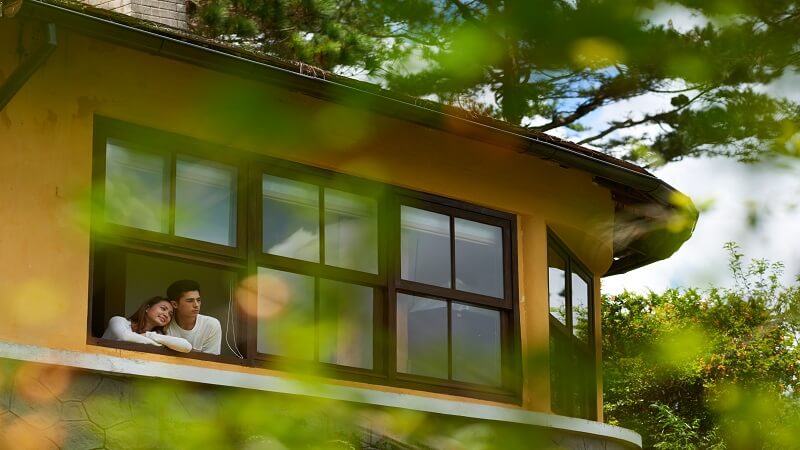Are you tired of your yard turning into a sizzling hotplate every summer? You’re not alone. Many cities, especially those in desert climates, experience the sweltering effects of urban heat islands. One way to combat this problem is to create refreshing spaces with green landscaping. This guide discusses the UHI effect, how landscape design helps address the issue, and practical tips you can implement.
Understanding Urban Heat Islands and Their Impact
Cities are abundant with heat-absorbing materials, like concrete and asphalt, and with limited natural landscapes, they tend to trap and retain more heat. Temperatures in these areas can be several degrees higher than in surrounding rural zones. Several factors contribute to this phenomenon:
- Less Airflow: Cities often have narrow streets and densely packed buildings. Because of this setting, the heat can’t dissipate effectively and causes the air to become warmer.
- Dark Surfaces: Asphalt roads and rooftops tend to trap sunlight and convert it into heat, raising overall temperatures.
- Lack of Shade: Trees, shrubs, and vegetation naturally cool the air through shade and the process of releasing water vapor. However, urban areas often lack this natural cooling mechanism.
The consequences of UHI go beyond mere discomfort. They include the following:
- Health Risks: Extreme heat can cause heat stroke or exhaustion and exacerbate respiratory problems. It’s particularly harmful for individuals with compromised health.
- Higher Energy Costs: As temperatures rise, people naturally turn up their air conditioning and rely on them heavily to maintain cool and comfortable indoor spaces. These systems generate more heat as they cool down areas and consume loads of electricity, driving up energy costs.
- Strained Infrastructure: When more people use air conditioning units, power stations must work harder to meet the increasing need for electricity. As a result, energy grids become overloaded, potentially leading to power disruptions.
- Environmental Stress: The cyclical nature of electricity use exhausts power grids, adding to greenhouse gas emissions. These pollute the air and create smog, which acts as a thermal layer and further increases temperatures. Poor air quality can also harm human health, cause acid rain, and speed up the formation of ground-level ozone.
How Eco-Friendly Landscaping Helps
Many people think landscape design is just about aesthetics; when planned and executed thoughtfully, it can improve quality of life and contribute to green initiatives. Here’s how strategically using plants and design elements directly addresses the impact of UHI:
- Natural Shade: Trees, especially those with spread-out branches, act as nature’s canopies. Their foliage can block sunlight and lessen the heat that the ground and surrounding air absorb.
- Less Heat Reflection: Green surfaces reflect less heat than concrete and asphalt. Incorporating more greenery helps reduce overall temperatures, the need for air conditioning, and their associated utility bills.
- Evaporative Cooling: Plants soak up water through their roots and release it through their leaves through transpiration. This process cools the surrounding air, similar to how sweating cools the human body.
Landscaping Ideas to Combat the Heat
Now that we’ve tackled the problem and how eco-friendly landscaping helps solve it, let’s delve into practical and effective strategies you can implement. These include:
- Shady Trees and Shrubs
Greeneries are your best allies against the scorching heat—strategically plant shade trees, preferably on your house’s south and west sides. Choose native or drought-tolerant species, like maple or oak, since they’re well-adapted to your local climate and soil conditions. These options are also easy and cost-efficient to maintain. For businesses, it’s best to incorporate trees and shrubs in warm areas, like building entrances, patios, and parking lots. - Green Roofs and Living Walls
Green spaces aren’t limited to the ground. Covering roofs and walls with vegetation is another powerful strategy for urban cooling. It also helps minimize energy consumption and costs, insulate buildings, improve air quality, and enhance your property’s aesthetic appeal.Homes and commercial establishments with smaller roofs can explore partial green roof installations. Growing vertical gardens on your exterior walls or trellises achieves the same effect.
- Mulch and Ground Cover
Beyond giving garden beds a pristine look, organic straw or wood chip mulch can prevent heat buildup. It locks moisture underground and insulates the soil, effectively cooling your home’s or establishment’s surroundings. You can also use ground cover plants, like creeping thyme, clover, and sedum, to further lower temperatures. - Permeable and Reflective Landscaping Materials
Concrete and asphalt hardscapes largely contribute to high temperatures in the city. So, swap them out for permeable alternatives that let water seep through. Gravel, turf, and porous pavers are excellent for walkways, driveways, and parking lots. These elements help replenish groundwater, reduce heat absorption, and cool the ground.Besides that, choose reflective and light-colored materials, paints, and coatings for roofs, walls, and pavements. They typically bounce off light that hits their surface, effectively minimizing trapped heat and cooling spaces.
- Water Features
Evaporating water naturally cools the air around it, so consider incorporating a fountain, pond, birdbath, or other water feature. For a more sustainable approach, you can also use tanks or barrels that collect rainwater.
Embrace a Cooler, Greener Future
Urban heat islands pose a growing challenge, but green landscaping offers a practical, aesthetic, and sustainable solution. By following the pointers above, homeowners and businesses can help lower temperatures, cut energy costs, and improve quality of life. Start implementing these strategies today for a greener and more livable environment.
